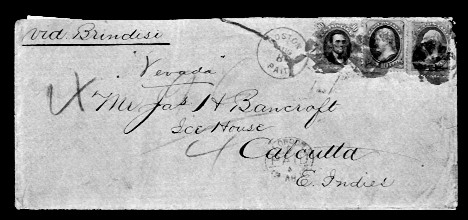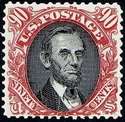
 |
Ice House Cover Surfaces in Midwest
| Friday, January 13, 2006 Filed: 17:30 PM
EDT (22:30 GMT) John Cropper, VSC Staff Reporter CHICAGO, ILLINOIS -- Chicago-area stamp dealer Charles Berg, owner of Stamp King has handled material both common and dear, from around the world. That didn't prepare him for the piece that recently crossed his counter quite unexpectedly, when an elderly couple wandered into his shop with what turned out to be a rare and unique piece of nineteenth-century postal history. |
|
| The couple, who had been cleaning out the homes of elderly relatives, brought three covers into his shop, wondering what they were worth. One was junk; half of it was missing. The other was fairly common, and only worth a dollar or two. The third however, was a rare cover that had been missing for more than thirty years. Originally part of the J. David Baker collection, which had been stolen from him in |
 Missing Gem Re-surfaces American Philatelic Research Library It may not look like much, but this one-of-a-kind period usage of a 90¢ Abraham Lincoln bi-color issue from 1869 could fetch a tidy ransom after having been missing for nearly forty years. (photo from Morgenthau's Philip B. Philip Sale catalog) |
|
Indianapolis on December 9, 1967, it was never recovered when the
remainder of the collection surfaced some time later. |
|
|
|
The 90¢ Abraham Lincoln stamp was part of the first two-color series of
stamps issued by the Post Office Department and was probably issued in
late March or early April, 1869. Off-cover copies exist in collectors'
hands. The largest known unused block is a vertical block of six, of which
there are two known, and there are approximately six unused blocks of four
and eight used blocks of four. However, the only known remaining piece
with the 90¢ stamp on it was the "Ice House" cover. After the theft, Baker collected insurance on his loss, so the insurance company ordinarily would have title. However, California lawyer and philatelist Jeffrey Forster has stated that he and another collector bought the rights, or perhaps an option to purchase, from the insurance company years ago. |
|
Novelty Then, Not Now Twenty-first century collectors are used to multi-colored stamps, but in 1869 they were considered a novel advance in stamp production |
|
|
|
|
| For more information about stamp
collecting, or
to find a local stamp club near you, visit the American Philatelic
Society's web site at www.stamps.org.
Free stamp collecting information is available from The Virtual Stamp Club
online at
www.virtualstampclub.com |
|
